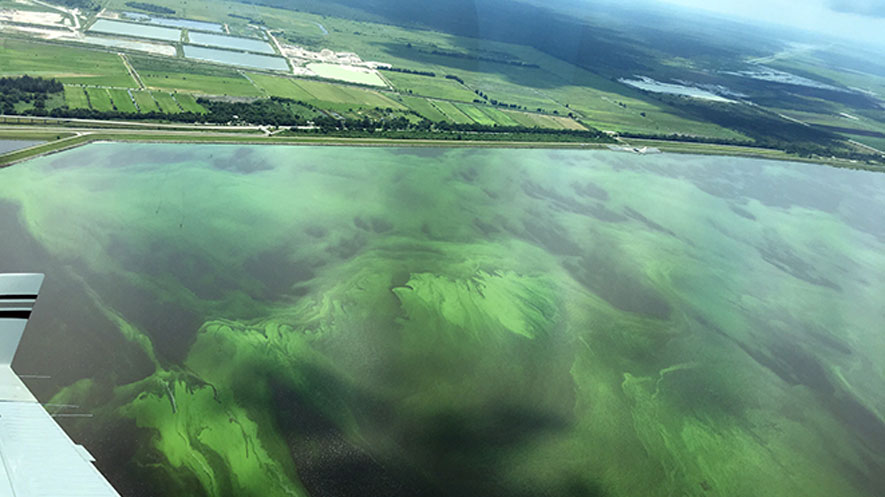For the second time in three years, Florida Gov. Rick Scott has issued a state of emergency in Lee and Martin counties, due to massive freshwater cyanobacteria blooms that have turned Lake Okeechobee and the Caloosahatchee and St. Lucie rivers into public health hazards.
Satellite imagery shows that as much as 90 percent of Lake Okeechobee is covered in cyanobacteria (so-called blue-green algae), which can produce toxins and lead to hypoxia-driven fishills. Because water from the lake is released by USACE-controlled discharges into the Caloosahatchee and St. Lucie rivers, local protesters blame USACE for allowing the algae to spread.
“There are cyanobacteria algae issues across the globe, but only one place where the government dumps it on you: Florida,” said Jacqui Thurlow-Lippisch, co-chair of the Rivers Coalition.
The USACE responded to public pressure by greatly reducing releases from Lake Okeechobee at the end of June. As the full releases were schedule to begin again, Sen. Marco Rubio (R-Miami) asked the Army Corps to further delay discharges into the St. Lucie river.
“South Florida faces major water issues that must be addressed,” said Rubio, “We have a plan in place that will help alleviate these issues, now we need the federal government to join Florida in investing enhanced resources for CERP as quickly as possible.”
CERP is the Comprehensive Everglades Restoration Plan enacted by the U.S. Congress, eighteen years ago, for the restoration of the Everglades ecosystem in southern Florida.
Will Restoration Do the Job?
During a 9 July 2018 boat tour of the Caloosahatchee, Scott blamed the U.S. Army Corps of Engineers (USACE) for the water quality problems, saying that the federal government has been too slow in completing Everglades restoration projects.
“I still get frustrated with the federal government because they’ve not been a great partner,” Scott said. “If they had funded all the projects that should be funded like the state has been doing over the last seven-and-a-half years, some of these events might not have happened."
Scott’s trip to Fort Myers comes one day after Sen. Marco Rubio (R-Miami) instructed the Army Corps to stop discharges and three days after Sen. Bill Nelson (D-Orlando) visited the Fort Myers area. Scott and Nelson are vying for the same Senate seat.
Symposium Looks at Impact of Biosolids on Water Quality
A full month before Scott declared his state of emergency, the Treasure Coast Regional Planning Council (TCRPC) and the Indian River Lagoon Council (IRLC) of the National Estuaries Program (NEP) sponsored a “Regional Biosolid Symposium” at the Indian River Chastain Campus Wolf High-Technology Center in Stuart Florida.
Florida’s central sewer wastewater treatment facilities produce approximately 340,000 tons of biosolids which are the effluents from central sewer wastewater treatment facilities.
Approximately 100,000 dry tons of biosolids are designated as Class B biosolids which are a designation for treated sewage sludge that meets U.S. EPA guidelines for land application as fertilizer with restrictions and are allowed to have detectable levels of pathogens. Another 100,000 dry tons of biosolids are deposited in various landfills throughout the state.
The final 140,000 dry tons of biosolids are further processed, dried, and composted with material from the landscape industry to produce approximately 200,000 tons of Class AA biosolids which, can then be distributed and marketed as fertilizer completely unregulated.
Both Class B biosolids and Class AA biosolid fertilizer contain approximately 5.5 % Total Nitrogen (TN) and 2.2% Total Phosphorus (TP). Therefore, the 300,000 dry tons of Class AA and Class B biosolids would contribute deposit over 33 million pounds of TN and 13.2 million pounds of TP on agricultural lands each year.
Michael Busha, Executive Director of the TCRPC began the June 08 event by introducing Henry Dean, St. Johns County Commissioner and former Executive Director for both the St. Johns River Water Management District and the South Florida Water Management District who provided opening remarks encouraging open minds and co-operative efforts.
The event included presentations by Wastewater Utility representatives from Palm Beach, Martin, St. Lucie, and Indian River Counties and the Florida Department of Environmental Protection presented current regulations on the disposal of biosolids.
A representative from the University of Florida’s Institute of Food and Agricultural Services (IFAS), Dr. Maria Silveira Ph.D., presented information on the fertilizer recommendations for pastures in Florida and explained the differences in P solubility and availability from various P sources and described the limitations associated with current soil testing using P as a tool to predict environmental hazards.
Presentations by Del Bottcher Ph.D. and Anthony Janicki Ph.D., included information on the current conditions and probable future trends of nutrients in lakes, streams, springs and our coastal estuaries. Their conclusions were though we have made progress in reducing nutrients within our surface waters we still need to do more.
The summit included Edith Widder, Ph.D., CEO and Senior Scientist for the Ocean Research and Conservation Association (ORCA) who commented on some concerns of compounds found in wastewater biosolids which may include; hormones, steroids, bacteria, viruses, polychlorinated biphenyls (PCB), pharmaceuticals, antibodies, Polybrominated diphenyl ethers (PBDE fire retardants), organics, metals, and artificial sweeteners. Although these materials are applied in a manner that may not be harmful to humans according the EPA "guide lines”, their accumulated secondary impacts are not entirely known.
According to Dr. Widder blue-green algae also known as cyanobacteria, can produce toxins to surface waters that can cause problematic respiratory issues. The toxins will also specifically target the liver and studies have documented liver damage and cancers from these toxins in cases from China to the Indian River Lagoon. The toxins may reduce crop production when found in irrigation water and they may actually be absorbed by the crop.
Gary Roderick an environmental consultant and former Environmental Administrator for the Florida Department of Environmental Protection gave a comprehensive presentation on nutrient loading and the progress being made in South Florida Basin Management Action Plans (BMAPS). He stressed the importance that bahia grass pastures in Florida can generally produce satisfactorily without TP fertilization and every crop in Florida can be grown economically without the use of biosolids as a fertilizer. It was indicated that biosolids provide an inefficient form of fertilization that provides only a fraction (less than 40%) of plant available nitrogen (PAN) which can result in both TN and TP over fertilization which may negatively affect surface and other coastal waters.
The main highlight to the summit came in the afternoon when first Todd O. Williams, P.E., BCEE Jacobs Engineering presented the importance and value of nutrient recovery and sustainable biosolids management which was immediately followed by a panel on the technologies and future trends in biosolids management.
The summit audience was given a look into the future of biosolid management. Instead of depositing biosolids into the landfill or using agricultural lands to dispose of biosolid wastes, there are alternatives that allow for recovery and sustainable management. The future of biosolid management was discussed by a panel chaired by Fred Mussari Ph.D. and included three new technologies.
Although each process is different, all three processes and capture energy from biosolids.
Kobe Nagar, P.E. presented Supercritical Water Oxidation or SCWO, which is a process that occurs in water at temperatures and pressures above a mixture's thermodynamic critical point. Under these conditions water becomes a fluid with unique properties that can be used to advantage in the destruction of hazardous wastes and the production of Co2, N2, O2 inorganics and pure water.
The Advanced Pyrolysis Technology system was presented by Steve Wirtel, P.E., a representative of Kore Infrastructure. This technology is made up of individual processes that operate in series: material handling, drying, high-temperature pyrolysis, and gas conversion into renewable natural gas, hydrogen, power generation. The process produces a crystallize form of carbon termed biochar that will sequester carbon into the soil and can be used as a soil supplement to provide soil structure, help retain water and does not contain nitrogen or phosphorus. The equipment used in each step is modular and compact to enable multiple system configurations and ease in siting requirements.
Peter Janicki, P.E., of Janicki Industries and Bioenergy provided information on Vapor Recompression Distillation (VRD) and Boiler Technology Electric Generation. The combination of these two technologies are also made up of individual components and processes that can operate in series to produce electricity, fresh distilled water, TN is converted to aqueous ammonium, and the TP ends up in its elemental form in the final ash. The aqueous ammonium can still be available as a more efficient N source for fertilizer, the electricity produced provides the power needed to operate the facility with excess electricity sold back to the power grid. The TP in the reduced volume of final ash can now be transported economically to areas that are currently depleted of nutrients such as “bread basket” in the middle of North America from years of the production of corn, wheat, and soy beans, or the Caribbean which has seen soil nutrient depletion from years of sugar cane production.
A final “Roundtable Panel” of summit participants and elected officials was moderated by the Executive Director of the Indian River Lagoon Council of the National Estuaries Program, Duane De Freese, Ph.D. with questions also being taken from the public. The discussion and public comment centered around how best to move forward to prioritize the review of existing alternatives with their economic analysis, funding and implementing the construction of Pilot Projects to eventually reduce the negative nutrient impacts to surface waters.
Jennifer Smith, the Director of the S.E. District Florida Department of Environmental Protection announced the creation of a Biosolids Technical Advisory Committee (TAC) to evaluate current management practices and potential opportunities for enhancements to better protect Florida’s water resources.
The proceedings from the summit may be found here.
An in-depth article from ECO Magazine covering the legal loopholes that allow for the overuse of biosolids can be found at here.





